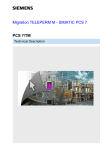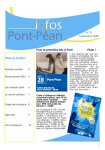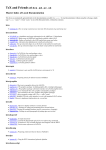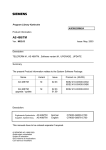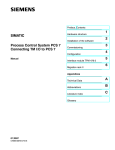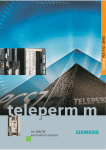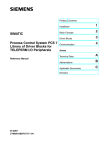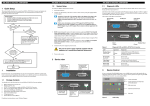Download Siemens Computer Hardware TM User's Manual
Transcript
PCS7 / TM (WinCC / TM)
V2.02
Product Information
This product information is more binding than current statements in Manuals and in the on-line help.
Product Information
PCS7/TM V2.02
Siemens AG 2001
1 of 21
24.10.2001
Chapter
Page
1
2
General Information ........................................................................................................................................ 3
What’s new ? ................................................................................................................................................... 3
2.1
CD content in general .............................................................................................................................. 3
2.1.1
TM_SmartTools............................................................................................................................... 3
2.2
TELEPERM M channel........................................................................................................................... 3
2.2.1
Modifications vs. Version V2.01..................................................................................................... 3
2.2.2
Restrictions ...................................................................................................................................... 4
2.3
PCS7/TM-OCX (NORA) (formerly: WinCC/TM-OCX (NORA)) ......................................................... 4
2.3.1
Modifications vs. Version V2.01..................................................................................................... 4
2.4
PCS7/TM-OCX (PCS7) (formerly: WinCC/TM-OCX (PCS7)) ............................................................. 5
2.4.1
Modifications vs. Version V2.01..................................................................................................... 5
3
General Information About the Installation..................................................................................................... 5
3.1
Operation system Windows NT, 4.0, Upgrading to SP5 ......................................................................... 5
3.2
Content of the CD.................................................................................................................................... 5
3.3
Installation using the Common Installation Mask ................................................................................... 5
3.4
Installation of the TELEPERM M Channel DLL and Tools ................................................................... 7
3.4.1
Installation of the N_AT/N_PCI driver ........................................................................................... 7
3.4.2
What to do after the Installation ?.................................................................................................... 7
3.5
Installation of the PCS7/TM-OCX (NORA) (formerly: WinCC/TM-OCX (NORA)) ............................ 7
3.5.1
Procedure of the manual installation................................................................................................ 8
3.5.2
Revision levels................................................................................................................................. 8
3.5.3
What to do after the installation ? .................................................................................................... 8
3.6
Installation of the PCS7/TM-OCX (PCS7) (formerly: WinCC/TM-OCX (PCS7)) ................................ 9
3.6.1
Procedure of the manual installation................................................................................................ 9
3.6.2
Revision levels................................................................................................................................. 9
3.6.3
What to do after the installation ? .................................................................................................... 9
3.6.4
Simultaneous Utilization of PCS7/TM-OCX( NORA) and PCS7/TM-OCX (PCS7) ................... 10
3.7
Necessary TM Licenses (Authorization) ............................................................................................... 11
3.7.1
Upgrade from WinCC/TM, V1.0x, to PCS7/TM, V2.0x............................................................... 11
4
Documentation .............................................................................................................................................. 12
5
Version Interdependencies ............................................................................................................................ 13
6
Conversion of a PCS 7/TM Project from WinCC 4.0x to 5.x ....................................................................... 13
Transition from WinCC, V5.0, to V5.0/SP2 (PCS7, V5.2) ............................................................................... 14
7
Creating a new PCS 7/TM project................................................................................................................. 15
7.1
Creating a Project for Multi-Client Operation on a Server .................................................................... 15
7.2
Creating a Multi-Client Project in a Multi-Client.................................................................................. 16
8
Bus Parameters for PROFIBUS TM System Bus on ASx88/TM and WinCC.............................................. 17
9
Important Notes ............................................................................................................................................. 18
9.1
Permissible Installations ........................................................................................................................ 18
9.2
Time in the Bus System......................................................................................................................... 18
9.3
Logical Connections .............................................................................................................................. 18
9.4
ZKS Blocks ........................................................................................................................................... 18
9.5
C Scripts ................................................................................................................................................ 18
9.6
Quantity Framework.............................................................................................................................. 18
9.7
PROGRAF AS+ .................................................................................................................................... 18
9.8
Manipulations in the AS ........................................................................................................................ 18
9.9
S Strings in TML Blocks ....................................................................................................................... 19
9.10 Structures of Field Blocks (GA, GB, etc) .............................................................................................. 19
9.11 Fonts ...................................................................................................................................................... 19
9.12 Number of Variables Under a Connection............................................................................................. 19
9.13 Troubleshooting Tips............................................................................................................................. 19
9.14 "Init" Button in System Parameter of the TELEPERM M channel/ CS 725 ......................................... 19
9.15 Start-up on Non-existing Function Blocks ............................................................................................ 19
9.16 Start-up on CS275 Device Number 0 .................................................................................................... 19
9.17 TELEPERM M in Intranet or Internet ................................................................................................... 20
10
Appendix ................................................................................................................................................... 20
10.1 Files and Search Paths ........................................................................................................................... 20
Product Information
PCS7/TM V2.02
Siemens AG 2001
2 of 21
24.10.2001
1 General Information
Scope of delivery
This CD contains the following components for PCS7-OS versions V4.02 and V5.2:
• TELEPERM M channel DLL
• Image blocks in TELEPERM M NORA representation: PCS7/TM-OCX (NORA)
• Image blocks in a representation similar PCS7: PCS7/TM_OCX (PCS7)
• Documentation and product information in pdf format - see chapter 4
• TELEPERM M tools such as „establish connection(*)“, ORPA import, block import, message generator
• Configuring tools TM_SmartTools including description (*)
(*) Only with version 5
The scope of delivery does not contain:
• System software WinCC, V5.0/ SP2+HF7, or PCS7-OS, V5.2
• Operating system Windows NT, 4.0, including Service Packs
2 What’s new ?
2.1
CD content in general
Starting the program Setup.exe in the root directory of the CD will identify the installed WinCC version
and branch to the corresponding version’s directory of the CD (PCS7_Version_4 or PCS7_Version_5).
For further information see chapter 3.3. If a valid version of WinCC cannot be identified the program
Setup.exe will be finished after a message box has been given out .
Under the directory PCS7_Version_5 you find in addition to the current version of the TELEPERM M
channel V2.02 also the older version V2.01 under the corresponding sub-directory.
2.1.1
TM_SmartTools
With Version_5 so called TM_SmartTools are delivered which support the configuration. These programs are delivered free of charge and without commitment. They may be copied to any directory of
the hard disk, preferably <...>\Siemens\TM_Werkzeuge and initialised from there. A short description
of the tools is delivered under the corresponding directory of the CD.
2.2
TELEPERM M channel
It is mandatory to install the TELEPERM M channel after the installation of the components for PCS7
or WinCC. If WinCC is installed later the TELEPERM M channel has to been reinstalled again.
2.2.1
Modifications vs. Version V2.01
The following problems have been eliminated:
•
Acceleration of the Message Generator
Because of using a new function within WinCC the generating procedure could be accelerated.
The following new functions have been implemented:
With the current version V5.0/SP2 + HF7 WinCC delivers a new function concerning redundancy:
• Switchover to the Master Server after CS 275 Coupling Start-up
When a server which is the master server for one or more multi-clients is activated these multiclients switch over to this master server not before the coupling start-up on the subsidiary AS is
Product Information
PCS7/TM V2.02
Siemens AG 2001
3 of 21
24.10.2001
•
terminated.
Switchover of the Servers after CS 275 Coupling Fault
When at least one connection to a subsidiary AS fails the multi-clients switch over to the redundant server. Attention ! An intentional switch off of a connection (AS) causes the same effect.
To activate these functions it is necessary to make an entry in the registry of the servers. This entry
can be made by double-clicking on the file Fault_ein.reg.
Double-clicking on the file Fault_aus.reg cancels this function.
Both files are stored in the CD directory <...>\PCS7_Version_5\Redundancy.
•
Channel Diagnosis
Hence the TELEPERM M Channel DLL uses the WinCC Channel Diagnosis. It is initiated via
\Simatic\WinCC\Tools\Channel Diagnosis. You should select the following basic configuration:
2.2.2
Restrictions
• Trends by Means of Measurement Points (function of WinCC-LTO)
This function will no longer be available from V5.0 onwards.
• Creating the WinCC Tag Management
The WinCC Tag Management (variable under connections) may solely be created via "TELEPERM
M Import blocks" wizard provided.
• Order of Simultaneously Occurring Messages in Alarm Logging
Simultaneously occurring messages of a function block (alarm, warning, tolerance) are given out in
order of the message numbers (WinCC system feature).
2.3
2.3.1
PCS7/TM-OCX (NORA) (formerly: WinCC/TM-OCX (NORA))
Modifications vs. Version V2.01
In addition to the present image blocks in TELEPERM M NORA representation we deliver a set of
renovated image blocks. They have identical display with the present ones, additionally they are supplemented with the properties “Modus” (display mode group/ loop), “Farbe_*” (color of bars and digital
values). For details see description “TELEPERM NORA renoviert.pdf”. The contractions G_ or K_ in
the OCX names have been dropped.
Product Information
PCS7/TM V2.02
Siemens AG 2001
4 of 21
24.10.2001
These blocks can be installed on demand by checking the component “Standard-OCX renoviert” in the
installation program.
2.4
2.4.1
PCS7/TM-OCX (PCS7) (formerly: WinCC/TM-OCX (PCS7))
Modifications vs. Version V2.01
None.
3 General Information About the Installation
Requirements
The software products that are contained on this CD are released under WinCC, Version 5.0/SP2+
HF7, or PCS7, Version 5.2, and Windows NT, 4.0 + SP5. The hardware requirements are listed in the
associated documents (Vertriebsfreigabe zu PCS7/TM, V2.02, in TELEPERM M aktuell).
With transition to PCS7, V5.2, the C partition of the used computer must have a memory of at least 4
GByte.
Please observe the Chapter 5 “Version Interdependencies” in this document.
3.1
Operation system Windows NT, 4.0, Upgrading to SP5
Note: The PCS 7/TM CD does not contain the operation system Windows NT, 4.0, or any Service
Packs (SP).
Language variants of the SP must be used according to the selection in the base installation.
To install the NT SP5, load the corresponding Setup.exe. Overwrite older files when the system asks
for file versions during the installation process. Please observe the notes etc. of the SP5.
3.2
Content of the CD
The software components for PCS 7/TM and the documents are supplied on CD-ROM.
CD directory structure under the directory PCS7_Version_5 (excerpt):
- Dok
- Siemens
- SW
- Winnt.400
3.3
Contains the product information and all the descriptions in pdf
format (see chapter 4)
Contains the channel components in an uncompressed form, 2
example projects as well as a part of a project and some Scripts
and functions
Contains the installation programs for channel and image blocks
(and additional products)
Contains the old driver software for the N_AT module
Installation using the Common Installation Mask
This CD is equipped with an “Autorun” facility that automatically starts the installation mask when the
CD is inserted (provided that the computer has been set up for this feature). If this selection has not
been made in your computer, the installation mask can also be initiated by double-clicking on the
setup.exe in the CD’s root directory.
Using the common installation mask it is sufficient to select all components to be installed.
When WinCC/TM is selected, the check is automatically set for the NAT-NPCI driver software. The
check can be removed if this driver software shall not be installed. The language selection in the inProduct Information
PCS7/TM V2.02
Siemens AG 2001
5 of 21
24.10.2001
stallation mask solely concerns the comments; the language of the installation proper must be specified separately.
Any old installation of the components that are to be installed will be removed at the beginning.
Each installation procedure may be started manually and separately using the file setup.exe in the
corresponding sub-directory.
Í It should be taken into consideration that during all installation procedures WinCC must be
terminated.
Product Information
PCS7/TM V2.02
Siemens AG 2001
6 of 21
24.10.2001
3.4
Installation of the TELEPERM M Channel DLL and Tools
The TELEPERM M channel-DLL and tools package must be installed in the following WinCC computers:
- Single-user system, also ES
- Client/ server system: in all servers, in the clients merely the TELEPERM M.chn channel and
all files of the Telpm*.lng. type.
- Multi-client system: in all servers, in the multi-clients merely the TELEPERM M.chn channel
and all files of the Telpm*.lng type.
The authorisation is supplied on a separate floppy disk.
Manual installation:
To install the TELEPERM M channel DLL and tools, please branch to the SW\ Kanal directory and
invoke Setup.exe there. From now on, the installation procedure will be prompted. The default setting
of <LW> is the installation drive of WinCC. This setting must not be changed.
If not already done explicitly at the beginning any existing installation will be removed during this process.
•
If it does not yet exist, the authorization must be transferred to the PCS 7 installation drive. To
do this, please insert the authorization floppy disk into the drive and double-click on the
Authors.exe or Authorsw.exe program (same procedure as for other PCS 7 components).
•
The installation is thus performed. Further information can be found in the
<LW>:\Siemens\TM_Werkzeuge\Liesmich.txt
file or in the documentation.
•
The files Ydata220.dat and Ydata230.dat that are included in the delivery contain the data that
is relevant for the W startup, and must not be modified.
•
Depending on the installed authorization, this software version permits communication with the
following automation systems:
- AS 230/ AS 235/ AS 235H/ AS 388/ AS 488
AS 215
AG 150U / AG 155U
- AS 220S/ AS 220H
(See also Chapter 3.7 "Necessary Licenses")
•
Startup features:
The AS systems are marked as failed during the entire duration of the startup phase.
Furthermore, all AS systems must be operational on the bus at the startup time.
3.4.1
Installation of the N_AT/N_PCI driver
If the N_AT driver is required, it can be installed via a separate installation procedure (NAT-NPCI).
Please execute the program Setup.exe in the directory sw\NAT_NPCI.
3.4.2
What to do after the Installation ?
After the successful installation all delivered TM configuration tools, i.e. wizards, should be imported
with the WinCC-Dynamic Wizard Editor.
This is not necessary if the Split Screen Wizard is executed (recommendation); herewith the current
TM configuration tools are copied into the project and are available there.
3.5
Installation of the PCS7/TM-OCX (NORA) (formerly: WinCC/TM-OCX
(NORA))
Product Information
PCS7/TM V2.02
Siemens AG 2001
7 of 21
24.10.2001
The image blocks in TELEPERM M-NORA representation and the authorization DLLs that are required for proper operation are in the directory sw\OCX_TM on the CD.
The authorization is supplied on a separate floppy disk.
This package must be installed in all computers that shall be used for operator communication and
visualization.
- Single-user system, also ES
- Multi-clients or Clients
- Server, if it is operator station at the same time.
3.5.1
Procedure of the manual installation
•
There is an older version of WinCC /TM-OCXs (NORA) in your computer and the objects
WinCC/TM-OCX (NORA) and VB5_DLL are contained in the "Settings/System control/Software" tab:
Uninstall these two objects.
•
To install the image blocks in TELEPERM M NORA representation branch to the SW\
OCX_TM directory and invoke Setup.exe there. The rest of the installation procedure will be
prompted. Also install the VB6_DLL (in the same setup).
If not already done explicitly at the beginning any existing installation will be removed during
this process.
The "Prototype images" option can be used for copying these images into the corresponding
WinCC folder from where they will be copied into the project when the Split Screen Wizard
executed.
•
The authorization must be transferred to the same drive as the other PCS7 authorizations. To
do this, please insert the authorization floppy disk into the drive and double-click on the
Authors.exe or Authorsw.exe program (same procedure as for other PCS7/ WinCC components).
Of course, this step is only necessary if an authorization has not yet been installed.
The image blocks in TELEPERM M NORA representation are now ready for the configuration in the
WinCC-Graphics Designer.
3.5.2
Revision levels
•
•
•
•
•
•
Elemente.ocx
TM_x.ocx
TM_MKS.ocx
TM_Sym
TM_AS215
TelepermMOCX.dll
V3.00.00
V3.00.00
V3.00.00
V3.00.00
V3.00.00
V1.0.0.3
(x stands for the different block types)
Image blocks (OCX) for the five standard function blocks TRAS, TRB, TRES, TRM and TRR are provided for the operation with AS 215. Their utilization is subject to change.
3.5.3
What to do after the installation ?
After the successful installation all optionally installed prototype images may be copied with the
WinCC-Split Screen Wizard into the current project.
Product Information
PCS7/TM V2.02
Siemens AG 2001
8 of 21
24.10.2001
3.6
Installation of the PCS7/TM-OCX (PCS7) (formerly: WinCC/TM-OCX
(PCS7))
The image blocks in a PCS7-similar representation and the authorization DLL that is necessary for
proper operation are located in the directory sw\OCX_TM7 on the CD.
The authorization is supplied on a separate floppy disk.
This package must be installed in all computers that shall be used for operator communication and
visualization:
- Single-user system, also ES
- Multi-clients or Clients
- Server, if the server is operator station at the same time.
3.6.1
Procedure of the manual installation
•
There is an older version of WinCC /TM-OCXen (PCS7) in your computer and the objects
WinCC/TM-OCX (PCS7) and VB5_DLL are contained in the "Settings/System control/Software" tab:
Uninstall these two objects.
•
To install the image blocks in PCS7-similar representation branch to the SW\ OCX_TM7 directory and invoke Setup.exe there. The further install procedure will be prompted. Also install
the VB6_DLL (in the same setup).
Any existing installation will be removed during this process.
The "Prototype images" option can be used for copying these images into the corresponding
WinCC folder from where they will be copied into the project when the Split Screen Wizard
executes.
•
The authorization must be transferred to the same drive as the other PCS7 authorizations. To
do this, please insert the authorization floppy disk into the drive and double-click on the
Authors.exe or Authorsw.exe program (same procedure as for other PCS7/ WinCC components).
Of course, this step is only necessary if an authorization has not yet been installed.
The image blocks in PCS7-similar representation are now ready for the configuration in the WinCCGraphics Designer.
Note: Some image blocks in PCS7-similar representation need more parameters in the ORPA filter
than the ones in TELEPERM M representation. Instead of the ORPAFilter.txt file that was copied into
the <LW>:\Siemens\WinCC\BSTMapper directory during the installation of the TELEPERM M channel,
ORPAFilter from the TM7 directory of the CD shall therefore be used. This directory also contains the
prototype images.
3.6.2
Revision levels
•
•
•
ElementeTM7.ocx
Input.ocx
TM7_x
3.6.3
What to do after the installation ?
V3.00.00
V3.00.00
V3.00.00
After the successful installation all optionally installed prototype images may be copied with the
WinCC-Split Screen Wizard into the current project.
Product Information
PCS7/TM V2.02
Siemens AG 2001
9 of 21
24.10.2001
3.6.4
Simultaneous Utilization of PCS7/TM-OCX( NORA) and PCS7/TM-OCX (PCS7)
Both image block types can be used simultaneously in a computer. However, the package of the image blocks in TELEPERM M NORA representation must first be installed.
If one of the simultaneously installed packages shall be removed, we strongly recommend to remove
both packages and to reinstall the one that shall remain.
Simultaneous utilization of the prototype images of both image types is not possible because
of identity of the objects’ names.
Product Information
PCS7/TM V2.02
Siemens AG 2001
10 of 21
24.10.2001
3.7
Necessary TM Licenses (Authorization)
Authorizations are installed in the <LW>:AX NF ZZ directory.
Depending on the employed channel, the following authorization must be stored there:
TELEPERM M channel DLL CS 275/ L2:
•
AS 23x, AS 488, AS 215, AG 150U
AG 155U only
•
AS 220 only
•
AS 220 and AS 23x, AS488, AS 215,
AG 150U, AG 155U
A7TMCS50
A7T2CS50
A7TACS50
This authorization must be installed in all computers that communicate with an AS.
If the installed channel and the authorization are not compatible with each other, a box appears during
runtime that states this incompatibility. The License.log file in the <LW>:\Siemens\WinCC\Diagnose
directory tells you which license is required for the installed channel.
Image blocks PCS7/TM-OCX:
•
The authorization A7TMFP50 is uniformly required for all image blocks.
It must be installed on each PC where operator input and visualization is required
3.7.1
Upgrade from WinCC/TM, V1.0x, to PCS7/TM, V2.0x
For this upgrade we offer the Upgrade package V2.0.
Changing from PCS7/TM, V2.00 to V2.01, or V2.01 to V2.02 the TM licences are not affected.
Important note:
Upon the migration from version V1.0x ... V1.05 to version V2.0 you will irrevocably lose the authorization for the
previous version.
We recommend to perform the migration of the authorization prior to the installation of PCS7/TM. The migration
requires the following preconditions to be fulfilled:
•
You possess a single license or a copy license for WinCC/TM; V1.0x on an authorization floppy disk or in
your computer.
•
You have purchased an upgrade license to PCS7/TM V2.0 (referred to as "authorization upgrade" in the text
below).
To upgrade the software from version V1.0x, use the following procedure:
1. The "old authorization" must be on the associated "old authorization floppy disk”. If necessary, you must first
transfer this authorization from your computer onto the "old authorization floppy disk".
2. Insert the "authorization floppy disk - upgrade” and invoke the "AuthorsW" program via the start bar under
Simatic > AuthorsW. If "AuthorsW" has not been installed in your computer, you must carry out the installation from the CD ("Setup.exe" in the Authors / Disk 1 directory). The "Extras" menu contains a menu item
"Upgrading guideline”. This guideline can support you during upgrading.
3. Select the "Authorization management" tab. Select the menu item "Upgrading..." from the "Authorization”
menu.
4. Select the upgrade program from the dialog that is opened subsequently. You will then be prompted to insert
the authorization floppy disk of the old authorization (V1.0x). Please follow the instructions on the screen and
insert the "Authorization floppy disk - upgrade" when you are prompted to do so.
5. Upgrading will be terminated when the new authorization V2.0 is activated on the "Authorization floppy disk upgrade".
6. The new authorization can now be transferred to your computer during the setup or using "AuthorsW”.
Product Information
PCS7/TM V2.02
Siemens AG 2001
11 of 21
24.10.2001
4 Documentation
Revised descriptions in pdf format are supplied in the dok\ directory on the delivery CD. Their contents
replace the printed descriptions.
•
PCS 7/TM (Name of the document: WinCC/TM))
Description of the TELEPERM M channel and the tools
order no. C79000-T8000-C740-xx
•
PCS 7/TM-OCX (NORA) (Name of the document: WinCC/TM-OCX (NORA))
Description of the image blocks in TELEPERM M NORA representation
order no. C79000-T8000-C741-xx
•
PCS 7/TM-OCX (PCS7) (Name of the document: WinCC/TM-OCX (PCS7))
Description of the image blocks in PCS7-similar representation
order no. C79000-T8000-C741-xx
•
WinCC/TM-OCX_Symbole
Description of the image blocks in symbol representation
•
WinCC/TM-OCX_AS215
Description of the image blocks for AS 215
•
MKS
Description of the single bit acknowledgement of the MKS block
•
TELEPERM NORA renoviert
Description of the “integrated” image blocks in TELEPERM M NORA representation
1
The Acrobat Reader is provided (ar40deu.exe) for reading the pdf files.
1
( "Acrobat Reader Copyright 1987-1999 Adobe Systems Incorporated. All Rights Reserved.
Adobe, the Adobe-Logo, Acrobat and the Acrobat-Logo are trademarks of Adobe Systems Incorporated")
•
TM_SmartTools
The description of the TM_SmartTools is stored in the corresponding directory as a file in Wordpad format.
Product Information
PCS7/TM V2.02
Siemens AG 2001
12 of 21
24.10.2001
5 Version Interdependencies
Program
WinCC
PCS7
V4.02 + SP3 +
HF1
V4
PCS7/TM-OS
Windows NT
V1.05
4.0 + SP5
Released Versions
V5.0/SP1 + HF5
V5.0/ SP2 +
HF2_K5.2.58.2
V5.0/SP1+HF2+
V5.1 +
HF5
HF2_K5.2.58.2
V2.00/ SP1
V2.01
4.0 + SP5
4.0 + SP5
V5.0 + SP2 + HF7
V5.2
V2.02
4.0 + SP5
6 Conversion of a PCS 7/TM Project from WinCC 4.0x to 5.x
This conversion requires special knowledge and should be realized by appropriate qualified personal
only. Following are the steps to be considered in short.
This explanation is valid for the language selection “German”.
A project that was created under WinCC 4.02 or an earlier version must first be converted for PCS7/
WinCC 5.x. The procedure that is described in the WinCC product information ("ReleaseNotes") must
basically be used. Observe this procedure.
To show this clearly, we point out the following mandatory steps:
•
Open the project with WinCC, V5.x
•
Edit the Split Screen Wizard
With single-user systems or multi-client systems, the area overview on the server now contains 16
areas instead of 12 previously.
With multi-client systems, one out of two area overviews can be selected on the multi-client:
• Across all servers with a total of 16 areas.
• Server-specific overview with 12 areas and an additional 6 server buttons,
Recommendation for the selection of the area overview in clients of multi-client systems:
The first variant should be selected in a system of no more than a total of 16 areas. The second
variant should be preferred in systems of more than 16 areas.
•
Edit the Alarm Logging Wizard
•
Convert the graphic images
•
Convert the global library
•
Convert the project library
•
Open tag logging and save to terminate.
•
Open the Picture Tree Manager and save to terminate it.
It can happen upon the migration of projects from WinCC version V4.0x to WinCC version 5 that
an OCX in a graphic image is either not recognized ("unknown object") or that the properties are
no longer visible in the Graphics Designer. The corresponding OCX must newly be placed in either case. Failure to do so will produce an error message when the Picture Tree Manager is
saved.
Product Information
PCS7/TM V2.02
Siemens AG 2001
13 of 21
24.10.2001
• Terminate WinCC and restart it afterwards.
• Start DynWizEdit. Read all four TELEPERM M wizards ("TELEPERM M Verbindung einrichten.wnf", ”TELEPERM M Import ORPA.wnf”, ”TELEPERM M Import Bausteine.wnf” and
”TELEPERM M Meldungen.wnf”) from the Siemens\WinCC\BSTMapper directory, and create a
CWD file.
Í When activating the Split Screen Wizard (from the current version V2.02) the current wizards are already included in the project !
•
Implementing the changes in the group display routing requires the variable management and the
ORPA definitions (structures) to be deleted and newly to be created. All TELEPERM M messages
must first be cleared.
• To implement the changes of the message generator, you must first start it and clear all existing
TELEPERM M messages. Next, you must start the message generator again and create default
message texts.
• Area-specific reporting
Using this function requires messages from function blocks (via status word) to be allocated to an
area in the sense of the Picture Tree Manager.
Manual allocation:
Each message concerned must be provided with an area name in the "Area" message block.
Allocation via EXCEL list and TM_RangMeld:
To make this allocation more convenient and easier to reproduce, it can be performed using the
TM_RangMeld program that is provided on the WinCC/TM CD and an EXCEL list that must be
created beforehand. See the corresponding description on the CD.
Allocation via exporting/importing with the Alarm Logging Editor:
Another possibility is the export of the relevant messages (set the selection accordingly) in Alarm
Logging into a file, editing the messages such that an area name is entered in the "Block:2" (=
area) column, and removing the associated TextID ("TextID 2") in the same line. Next, reimport the
file in Alarm Logging.
• The converted project must be a "multi-user system" if it shall be used as a server in multi-client
operation. With an empty test point list (that was filled by the tag editor up to V4.02), there may be
an error message when the package is created that is required for multi-client operation. This error
message can be ignored in most cases. However, you should ensure that the package has been
created in the "Package" subdirectory of the directory that bears the name of the computer.
Transition from WinCC, V5.0, to V5.0/SP2 (PCS7, V5.2)
Special measures are not required for this transition. The Es WinCC wizards Split Screen Wizard and
Alarm Logging Wizard should always be activated. This is to guarantee that modifications and enhancements will be transferred into the project.
Product Information
PCS7/TM V2.02
Siemens AG 2001
14 of 21
24.10.2001
7 Creating a new PCS 7/TM project
This explanation is valid for the language selection "German". Please observe the WinCC/ PCS 7
product information ("ReleaseNotes")..
7.1
Creating a Project for Multi-Client Operation on a Server
• Create the project as a multi-user project with WinCC/ PCS7, > V5.0.
It must be noted here that the server name and the project name in the multi-client are both displayed according to the selection of the area overviews: The names of the two components should
therefore not be excessively long.
• Edit the Split Screen Wizard
• Edit the Alarm Logging Wizard
• Insert new driver for the TELEPERM M channel in the variable management.
• Start DynWizEdit and read all 4 TELEPERM M wizards ("TELEPERM M Verbindung einrichten.wnf", ”TELEPERM M Import ORPA.wnf”, ”TELEPERM M Import Bausteine.wnf” and
”TELEPERM M Meldungen.wnf”) from the Siemens\WinCC\BSTMapper directory and create CWD
file.
Note: When activating the Split Screen Wizard (from the current version V2.02) the current wizards
are already included in the project !
• Execute wizard "TELEPERM M Verbindung einrichten" and define the desired connections.
• Execute ”Import TELEPERM M ORPAs” once or twice (user or TML blocks).
ÍPlease do not forget that importing so called field blocks (GA, GB, etc.) always only 1
element is generated; additional elements have to be defined manually before executing the
import of TELEPERM M blocks.
• Execute ”Import TELEPERM M blocks”.
• Execute ”TELEPERM M messages” and create default message texts.
• Area-specific reporting
Using this function requires messages from function blocks (via status word) to be allocated to an
area in the sense of the Picture Tree Manager.
Manual allocation:
Each message concerned must be provided with an area name in the "Area" message block.
Allocation via EXCEL list and TM_RangMeld:
To make this allocation more convenient and easier to reproduce, it can be performed using the
TM_RangMeld program that is provided on the WinCC/TM CD and an EXCEL list that must be
created beforehand. See the corresponding description on the CD.
Prior to this step, you should expediently create the topmost area level in the Picture Tree Manager.
• If necessary, the TELEPERM M message class must be included in the selection of the individual
message windows.
• Next, all further configuration steps are performed.
Product Information
PCS7/TM V2.02
Siemens AG 2001
15 of 21
24.10.2001
• Once the configuration has been completed, a package for the operation from a multi-client must
be created under Serverdata. In the project, the package is created in the "Package" subdirectory
of the directory that bears the name of the computer.
7.2
Creating a Multi-Client Project in a Multi-Client
•
Create the project as a multi-client system with WinCC/ PCS7, > V5.0x
•
Edit the Split Screen Wizard
Selection between two area overviews is possible in the multi-client:
• Across all servers with a total of 16 areas.
• Server-specific overview with 12 areas and an additional 6 server buttons,
Recommendation for the selection of the area overview in clients of multi-client systems:
The first variant should be selected in a system of no more than a total of 16 areas. The second
variant should be preferred in systems of more than 16 areas.
•
Edit the Alarm Logging Wizard
•
Import the server packages
•
Create the operator input privileges in the User Administrator
•
Define the standard server for alarm logging
This definition must be made to store the operator communication messages of a multi-client in a
server (the selected default server).
• The connection to the servers is established under Serverdata by loading the packages.
Product Information
PCS7/TM V2.02
Siemens AG 2001
16 of 21
24.10.2001
8 Bus Parameters for PROFIBUS TM System Bus on ASx88/TM
and WinCC
Parameter
description
DOS_CONF.DAT L2AMPRO.INI ConfiguraValue
in
tion dialog in
in AS488 and
Bridge
ASx88
Windows NT
for WinCC
Highest station address
l2_hsa
l2_hsa
Highest Station Address
Local device address
l2_ts
l2_ts
Local Station 1 .... 99
Address
Baud rates (index)
l2_baud_rate
l2_baud_rate
Transmission
Rate
1,5 Mbits/s
Slot time
l2_tsl
l2_tsl
Tslot
3000
Quiet time
l2_tqui
l2_tqui
Tqui
0
Setup time
l2_tset
l2_tset
Tset
240
Minimum station delay
time
l2_max_tsdr
l2_max_tsdr
Max Tsdr
980
Maximum station delay
time
l2_min_tsdr
l2_min_tsdr
Min Tsdr
150
Token rotation time
l2_ttr
l2_ttr
Ttr
min.
90000
GAP factor
l2_g
l2_g
Gap factor
30
Call repetitions
l2_retry_ctr
-
Retry Limit
1
Ready time
-
-
Trdy
150
Idle time 1
-
-
Tid1
515
Idle time 2
-
-
Tid2
980
1 .... 126
*)
**)
•
The PROFIBUS bus parameters for WinCC are specified in the user-defined profile. But for the Ttr parameter, the values of the general-purpose profile will be transferred to the user-defined profile if the generalpurpose profile is selected beforehand. In this case, these values are almost identical to the abovementioned ones.
•
*) Use the following formula to calculate the Ttr parameter, and enter it:
Ttr (l2_ttr) = 9000 * [number of active PROFIBUS-TM devices].
Note: The factor 9000 in the formula is only valid for a baud rate of 1.5 Mbits/s.
•
**) For the baud rate of 1.5 Mbits/s, the default value of the gap factor is 30 – 50. Entering a smaller value
may be necessary in exceptional cases.
•
All specified bus parameters are tuned to the baud rate of 1.5 Mbits/s. Any change/optimization requires a
deep knowledge of the PROFIBUS standard.
•
The bus parameters for all TELEPERM components (e.g. OS525 and PROGRAF AS) on the PROFIBUS TM
system bus must be selected accordingly.
Product Information
PCS7/TM V2.02
Siemens AG 2001
17 of 21
24.10.2001
9 Important Notes
9.1
Permissible Installations
Software products that are not mandatory for the operation of PCS7 must not be installed in servers,
clients or multi-clients. This includes MS Office, for example. This shall prevent that the installation of
other software components (such as DLLs) has a detrimental influence on the system behavior.
9.2
Time in the Bus System
Time synchronization is mandatory in the bus system. Consistent message processing is not possible
otherwise. A PCS7/TM OS should be time master, the time of the other PCs should be synchronized
with the PCS7 tool DCS77 client.
9.3
Logical Connections
Creating logical connections with the same CS275 address is not permitted. The name of a logical
connection must not contain any special character (including "_"). This means that AS_103 is not permitted.
9.4
ZKS Blocks
The access to ZKS blocks has not been implemented.
9.5
•
•
•
9.6
C Scripts
General: We expressively want to point out again here that the general conventions of the programming language C must be observed when scripts are employed. Failure to do so may cause
unpredictable reactions that can strongly affect proper operator communication and visualization.
When connecting a graphical object with a script only the value of the object is transferred. This
value will be signed “valid” independent of the state of the value.
When dynamising the property “tagname “ of an OCX it should be taken care that this it not carried out cyclically.
Quantity Framework
When project images are configured in WinCC/TM, the capacity utilization of the bus system and of
the subordinate automation systems must be taken into consideration in addition to the specifications
of the permissible mixed quantity framework / see TELEPERM M aktuell 1998/011/. A server may be
charged with max. 600 variables/ second.
9.7
PROGRAF AS+
Utilization of PROGRAF AS+ data for the function ORPA import or block import as a function of the
employed automation system:
ORPA import
Block import
AS 23x/ AS x 88
X
X
AS 220
X
- 1)
AS 215
- 2)
- 1)
AG 155U
- 2)
- 1)
1) Can be generated with theTM_SmartTool genBST.
2) On demand. Please contact your Siemens sales partner.
9.8
Manipulations in the AS
Product Information
PCS7/TM V2.02
Siemens AG 2001
18 of 21
24.10.2001
With manipulations in the AS it must be ensured that - depending on the measure - messages etc.
may be lost via status message frames and/ or MKS message frames. Setting the AS in a defined
state first is therefor expedient.
9.9
S Strings in TML Blocks
Only the first character of a parameter of the "S" type in a TML block can be read.
9.10 Structures of Field Blocks (GA, GB, etc)
Only one structure definition is possible for each field type. All configured fields in the AS must show at
least this length.
The export of PROGRAF AS merely creates the first element. Any other element must be added
manually. The 0th element must also be created manually if it shall be read.
A length between 1 and 256 is possible.
9.11 Fonts
"Large fonts" must not be selected in the screen properties.
9.12 Number of Variables Under a Connection
A maximum of 64k variables may be created under an AS connection.
9.13 Troubleshooting Tips
Í License Problems at Runtime
Frequently, the TELEPERM M hotline is notified of license problems that are signalled during runtime
after the TELEPERM M channel has been installed. In all cases this is due to the fact that an authorization was purchased for the operation with AS 23*, while version “AS 23* and AS 220" was specifically selected during the installation process. The problem is eliminated when installation is repeated
correctly.
Version and AS type of the TELEPERM M channel are stored in the registry code
HKEY_LOCAL_MACHINE\Software\Siemens AG\WinCC_TM under "Version" or "AS-Typ" respectively.
This information can be retrieved via the program TM_Info (in the TM_Werkzeuge directory).
Í Missing Texts in Image Blocks
Likewise, customers frequently report that texts are not displayed in the image blocks during runtime
after the WinCC/TM-OCX (NORA) has been installed. This is due to the fact that - contrary to the requirement fixed in the description - these image blocks were not configured via the property box. Once
the image blocks have been edited via this property box, the texts are transferred and are displayed by
the image blocks during runtime.
Í Message of the Teleperm M Class
For various function blocks, the TELEPERM M message generator creates messages of the
TELEPERM M class. Since this class is obviously not contained in the prefabricated WinCC message
images, they must be incorporated by the configuring engineer if this is required.
9.14 "Init" Button in System Parameter of the TELEPERM M channel/ CS 725
This button may not pressed at runtime in any case.
9.15 Start-up on Non-existing Function Blocks
The coupling start-up on function blocks that do not exist in the AS is extended for some minutes per
block.
9.16 Start-up on CS275 Device Number 0
Product Information
PCS7/TM V2.02
Siemens AG 2001
19 of 21
24.10.2001
Device number 0 is reserved on all CS 275 busses and therefore may not be used.
9.17 TELEPERM M in Intranet or Internet
Please refer to the following sites for current information about TELEPERM M, especially FAQs:
Homepage (extern): http://www.ad.siemens.de/teleperm/index_00.shtml
Homepage (intern): http://intra1.nbgm.siemens.de/extern/spiegeln/teleperm/index_00.shtml
10 Appendix
10.1 Files and Search Paths
The following files are copied when theTELEPERM M channel is installed:
<LW>:\Siemens\TM_Werkzeuge\Liesmich.txt
<LW>:\Siemens\TM_Werkzeuge\Regini.exe
<LW>:\Siemens\TM_Werkzeuge\Wincc.ldb
<LW>:\Siemens\TM_Werkzeuge\TM_Info.exe
<LW>:\Siemens\WinCC\bin\NrmTelpm.nll
<LW>:\Siemens\WinCC\bin\TELEPERM M WNF Support.dll
<LW>:\Siemens\WinCC\bin\TELEPERM M.chn
<LW>:\Siemens\WinCC\bin\Telpmdeu.Ing
<LW>:\Siemens\WinCC\bin\Telpmenu.Ing
<LW>:\Siemens\WinCC\bin\Telpmfra.Ing
<LW>:\Siemens\WinCC\bin\Ydata220.Dat
<LW>:\Siemens\WinCC\bin\Ydata230.Dat
<LW>:\Siemens\WinCC\bin\TM_RangMeld.exe
<LW>:\Siemens\WinCC\BSTMapper\BSTFilter.txt
<LW>:\Siemens\WinCC\BSTMapper\Logotm.bmp
<LW>:\Siemens\WinCC\BSTMapper\ORPAFilter.txt
<LW>:\Siemens\WinCC\BSTMapper\TELEPERM M Import Bausteine.wnf
<LW>:\Siemens\WinCC\BSTMapper\TELEPERM M Import ORPA.wnf
<LW>:\Siemens\WinCC\BSTMapper\TELEPERM M Meldungen.wnf
<LW>:\Siemens\WinCC\BSTMapper\TELEPERM M PseudoAS.wnf
<LW>:\Siemens\WinCC\BSTMapper\TELEPERM M Verbindung einrichten.wnf
<LW>:\Siemens\WinCC\BSTMapper\TELEPERM M WNF Support.h
<LW>:\Siemens\WinCC\BSTMapper\BSTMapper.deu\BSTFilter.txt
<LW>:\Siemens\WinCC\BSTMapper\BSTMapper.deu\Logotm.bmp
<LW>:\Siemens\WinCC\BSTMapper\BSTMapper.deu\ORPAFilter.txt
<LW>:\Siemens\WinCC\BSTMapper\BSTMapper.deu\TELEPERM M Import Bausteine.wnf
<LW>:\Siemens\WinCC\BSTMapper\BSTMapper.deu\TELEPERM M Import ORPA.wnf
<LW>:\Siemens\WinCC\BSTMapper\BSTMapper.deu\TELEPERM M Meldungen.wnf
<LW>:\Siemens\WinCC\BSTMapper\BSTMapper.deu\TELEPERM M PseudoAS.wnf
<LW>:\Siemens\WinCC\BSTMapper\BSTMapper.deu\TELEPERM M Verbindung einrichten.wnf
<LW>:\Siemens\WinCC\BSTMapper\BSTMapper.deu\TELEPERM M WNF Support.h
<LW>:\Siemens\WinCC\BSTMapper\BSTMapper.deu\BSTFilter.txt
<LW>:\Siemens\WinCC\BSTMapper\BSTMapper.enu\Logotm.bmp
<LW>:\Siemens\WinCC\BSTMapper\BSTMapper.enu\ORPAFilter.txt
<LW>:\Siemens\WinCC\BSTMapper\BSTMapper.enu\TELEPERM M Import Bausteine.wnf
<LW>:\Siemens\WinCC\BSTMapper\BSTMapper.enu\TELEPERM M Import ORPA.wnf
<LW>:\Siemens\WinCC\BSTMapper\BSTMapper.enu\TELEPERM M Meldungen.wnf
<LW>:\Siemens\WinCC\BSTMapper\BSTMapper.enu\TELEPERM M PseudoAS.wnf
<LW>:\Siemens\WinCC\BSTMapper\BSTMapper.enu\TELEPERM M Verbindung einrichten.wnf
<LW>:\Siemens\WinCC\BSTMapper\BSTMapper.enu\TELEPERM M WNF Support.h
<LW>:\Siemens\WinCC\BSTMapper\BSTMapper.fra\BSTFilter.txt
<LW>:\Siemens\WinCC\BSTMapper\BSTMapper.fra\Logotm.bmp
<LW>:\Siemens\WinCC\BSTMapper\BSTMapper.fra\ORPAFilter.txt
<LW>:\Siemens\WinCC\BSTMapper\BSTMapper.fra\TELEPERM M Import Bausteine.wnf
<LW>:\Siemens\WinCC\BSTMapper\BSTMapper.fra\TELEPERM M Import ORPA.wnf
<LW>:\Siemens\WinCC\BSTMapper\BSTMapper.fra\TELEPERM M Meldungen.wnf
<LW>:\Siemens\WinCC\BSTMapper\BSTMapper.fra\TELEPERM M PseudoAS.wnf
<LW>:\Siemens\WinCC\BSTMapper\BSTMapper.fra\TELEPERM M Verbindung einrichten.wnf
Product Information
PCS7/TM V2.02
Siemens AG 2001
20 of 21
24.10.2001
<LW>:\Siemens\WinCC\BSTMapper\BSTMapper.fra\TELEPERM M WNF Support.h
The following files are copied when the WinCC/TM-OCX (NORA) package is installed:
<LW>:\Siemens\WinCC\bin\ccGraphics\WinCCDataServer.dll
<LW>:\Siemens\WinCC\bin\ccGraphics\ccUserAdmin.dll
<LW>:\Siemens\WinCC\bin\ccGraphics\CCOperationMessage.dll
<LW>:\Siemens\TM_ocx\TelepermMOCX.dll
<LW>:\Siemens\TM_ocx\Elemente.ocx
<LW>:\Siemens\TM_ocx\IXSimpleBar.ocx
<LW>:\Siemens\TM_ocx\TM_A.ocx
<LW>:\Siemens\TM_ocx\TM_B.ocx
<LW>:\Siemens\TM_ocx\Tm_C.ocx
<LW>:\Siemens\TM_ocx\TM_DZ.ocx
<LW>:\Siemens\TM_ocx\TM_EG.ocx
<LW>:\Siemens\TM_ocx\TM_EK.ocx
<LW>:\Siemens\TM_ocx\TM_EU.ocx
<LW>:\Siemens\TM_ocx\TM_F.ocx
<LW>:\Siemens\TM_ocx\TM_FN.ocx
<LW>:\Siemens\TM_ocx\TM_M.ocx
<LW>:\Siemens\TM_ocx\TM_MSB.ocx
<LW>:\Siemens\TM_ocx\TM_R.ocx
<LW>:\Siemens\TM_ocx\TM_RE.ocx
<LW>:\Siemens\TM_ocx\TM_RI.ocx
<LW>:\Siemens\TM_ocx\TM_RK.ocx
<LW>:\Siemens\TM_ocx\TM_RN.ocx
<LW>:\Siemens\TM_ocx\TM_S.ocx
<LW>:\Siemens\TM_ocx\TM_TVB.ocx
<LW>:\Siemens\TM_ocx\TM_V.ocx
<LW>:\Siemens\TM_ocx\TM_MKS.ocx
<LW>:\Siemens\TM_ocx\TM_Sym.ocx
<LW>:\Siemens\TM_ocx\Zusanz.ocx
<LW>:\Siemens\TM_ocx\TM_GLobal.dll
<LW>:\Siemens\TM_ocx\Language.dll
<LW>:\Siemens\TM_ocx\OCX_Texte407.dll
<LW>:\Siemens\TM_ocx\OCX_Texte409.dll
<LW>:\Siemens\TM_ocx\OCX_Texte40A.dll
<LW>:\Siemens\TM_ocx\OCX_Texte40C.dll
<LW>:\Siemens\TM_ocx\OCX_Texte40E.dll
<LW>:\Siemens\TM_ocx\OCX_Texte413.dll
<LW>:\Siemens\TM_ocx\OCX_Texte41D.dll
<LW>:\Siemens\TM_ocx\TMOCX.dll
<LW>:\Siemens\TM_ocx\TMCOND.dll
<LW>:\Windowsdir\TMOCX.ini
The following files are copied when the WinCC/TM-OCX (PCS7) package is installed:
<LW>:\Siemens\TM_ocx\TM_GLobal.dll
<LW>:\Siemens\TM_ocx\TelepermMOCX.dll
<LW>:\Siemens\TM_ocx\TMOCX.dll
<LW>:\Siemens\TM7_ocx\ElementeTM7.ocx
<LW>:\Siemens\TM7_ocx\Input.ocx
<LW>:\Siemens\TM7_ocx\TM7_A.ocx
<LW>:\Siemens\TM7_ocx\TM7_A_MotVen.ocx
<LW>:\Siemens\TM7_ocx\TM7_B.ocx
<LW>:\Siemens\TM7_ocx\TM7_C.ocx
<LW>:\Siemens\TM7_ocx\TM7_F.ocx
<LW>:\Siemens\TM7_ocx\TM7_FN.ocx
<LW>:\Siemens\TM7_ocx\TM7_M.ocx
<LW>:\Siemens\TM7_ocx\TM7_R.ocx
<LW>:\Siemens\TM7_ocx\TM7_RN.ocx
<LW>:\Siemens\TM7_ocx\TM7_V.ocx
<LW>:\Siemens\TM7_ocx\PCX_Texte407.dll
<LW>:\Siemens\TM7_ocx\PCX_Texte409.dll
<LW>:\Siemens\TM7_ocx\PLanguage.dll
<LW>:\Windowsdir\TMOCX.ini
Product Information
PCS7/TM V2.02
Siemens AG 2001
21 of 21
24.10.2001























